Bokashi Bin: What You Need To Know To Make Amazing Compost
This website may earn commissions from purchases made through links in this post.
Make amazing compost from all your food scraps and reduce waste with a Bokashi bin.
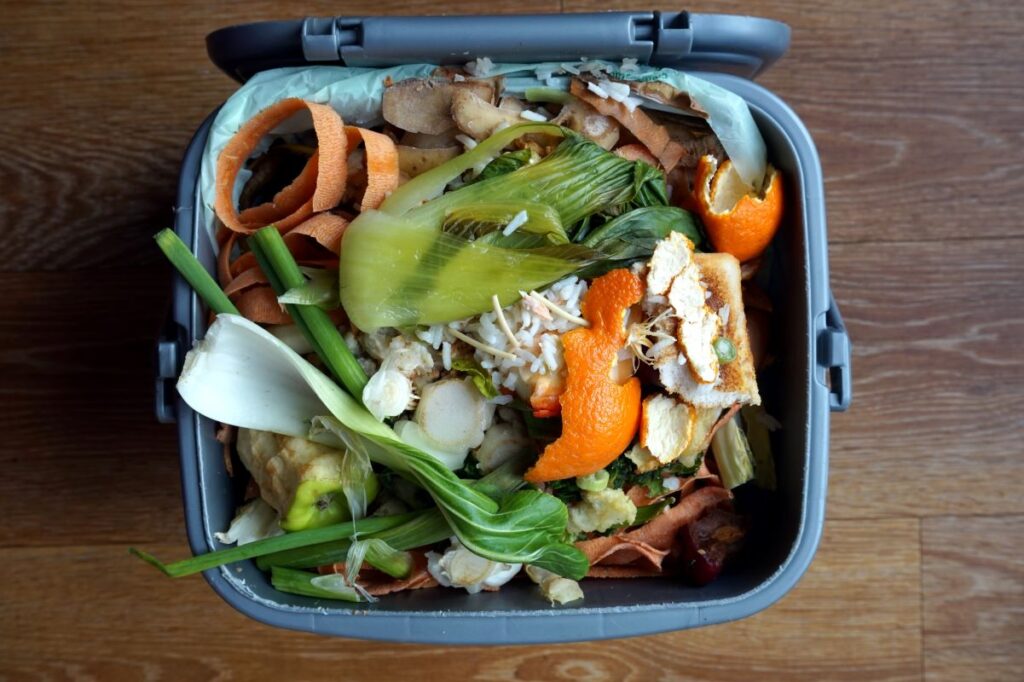
Are you looking for a convenient way to eliminate your food waste?
One solution – even for apartment dwellers – is the Bokashi Bin. This is an indoor, small space system for “composting” food scraps. It will help you reduce food waste that ends up in landfill. We have invested in a Bokashi bucket as well as a compost bin, and it’s had a huge impact on the amount of waste that goes into our bin!
This article will cover everything you need to know about Bokashi – what it is, its many benefits, how to use it, and how to make the most of your Bokashi waste.
Make amazing compost full of beneficial microorganisms your plants will love, and cut down on waste with a Bokashi bucket.
Here’s how.
What Is A Bokashi Bin?
A Bokashi bin/bucket is an indoor “composting” system. It’s called composting because it cuts your food waste, but unlike traditional composting, it basically pickles your food rather than compost it. Once your food has fermented in the bucket, it still needs to be further broken down.
The system of fermenting food before composting was invented by Japanese professor of agriculture Dr Teruo Higa in 1982. It uses a select variety of microorganisms to pickle your kitchen scraps. These beneficial microorganisms are lactic acid bacteria, yeasts and photosynthetic bacteria and are known as Effective Microorganisms or EM.1® for short.
In the Bokashi composting system, you add these beneficial microbes to food waste in the form of dry inoculated bran, which you sprinkle over your scraps. Some systems use a spray instead – it’s up to you which you prefer.
For more information on the history and science, check out this video:
How Does A Bokashi Bucket Work?
The Bokashi is an anaerobic system (no oxygen) of friendly microorganisms that “pre-digest” kitchen scraps before you dig them directly into your garden, add them to your compost bin, or add them to your worm bin.
The Bokashi system comprises a bucket with a tight-fitting lid to create the essential anaerobic (airless) environment, a grate in the bottom of the bucket to allow the food scraps to drain, and a spigot at the bottom to drain off this beneficial Bokashi “tea”.
Once you place your scraps in the bucket at the end of each day, add a handful of the inoculated bran or a few sprays of the friendly bacteria, fit the lid on tight and let the micro bugs get to work.
When the bin is full, you can dig it directly into your garden or, better still, leave it to ferment for a further two weeks before adding it to your garden.
What Are The Benefits Of Having A Bokashi Bucket?
If a Bokashi Bucket doesn’t compost your food scraps, what’s the point of having one?
The benefits are:
- Bokashi processes almost ALL of your scraps.
- You can use a Bokashi Bucket to process scraps even in an apartment or small space living.
- If you have a worm farm, you can use a Bokashi Bucket to pre-process your food scraps. The worms can eat some food scraps they couldn’t beforehand.
- Traditional composting can take months. Bokashi waste breaks down quickly once fermented (about 6 weeks), speeding up the composting process.
- Using a Bokashi Bucket to deal with food scraps is clean, easy, and requires little maintenance.
- Your food scraps won’t smell bad and won’t attract flies so you can keep your Bokashi Bucket inside.
- We all tend to follow the path of least resistance. The easier you make composting, the more likely you and your family will do it.
- Studies have shown that using microorganisms in the soil reduces soil-borne pathogens and increases the decomposition of organic matter. This makes nutrients available to plants quicker, promoting plant growth. You can get a summary of these studies on the Permaculture News page.
- This study found an increase in macro and micronutrients in the soil when using microorganisms instead of conventional composting. And this study revealed healthier plants, increased yields and decreased disease and pests when using compost decomposed with microorganism EM technology. All of this is great news for the home gardener and agriculture in general!
What Can You Put In A Bokashi Bucket?
Bokashi can handle a wider range of food scraps than you can put in a regular compost system or worm farm. The scraps you can put in your Bokashi Bucket include:
- All fruit and vegetable scraps (raw and cooked)
- Seeds and nuts
- Eggshells (give them a bit of a squash to break them up)
- Meat and Fish
- Bread, cakes, crackers etc.
- Cooked food (rice, pizza crusts etc.)
- Coffee grounds, tea leaves, and tea bags (as long as they are paper, not plastic)
- Paper products like tissues
- Dairy (like cheese)
- Spent flowers
- Small bits of wood, like toothpicks or bamboo skewers
What should you NOT put in your Bokashi Bucket?
- Food that is already rotten or mouldy. You want your scraps to pickle, not rot in your bin.
- Large bones
- Shellfish shells, like hard crab shells
- Synthetic tea bags or staples
- Liquids like milk. You want to avoid getting your Bokashi too wet.
- If you add cooked food scraps, like those from making your own stock, drain them so they’re not too wet.
How To Use Your Bokashi Bucket – Step-By-Step Instructions
Are you encouraged by the list of Bokashi benefits?
Here’s how to use it:
Step 1 – install the tap and insert the grate in the bottom of the bin. Make sure the tap is turned off.
Step 2 – Put your kitchen waste into the bucket and press it down to compact. Some brands come with a trowel for this purpose. Or you can use a potato masher or scrap paper, which you can leave in the bucket.
Step 3 – Sprinkle a handful of the Bokashi bran over your kitchen scraps. How much? About a tablespoon of bran for every cup of waste. Err on the side of more, not less. And if you are adding meat, dairy or other oily or protein-rich foods, add extra bokashi bran as these foods take longer to break down. Or you can spray your kitchen scraps with the Bokashi spray. Use two or three sprays to cover your scraps – more for meats etc.
Step 4 – Cover with the lid and check that it is on tight.
Step 5 – Repeat layering your kitchen scraps with the Bokashi mix.
Step 6 – Regularly drain the liquid to avoid rot – about once or twice a week, more if necessary.
Step 7 – Once your bucket is full, dig the contents into your garden or add them to your compost heap. If you have two buckets, you can leave the contents to pickle for a further two weeks while you’re filling the second bucket.
Step 8 – Rinse your empty bucket with water (no detergents!) and start again.
The key things to remember when using your Bokashi are:
Does A Bokashi Bucket Smell Bad?
If you’re composting inside the house, you don’t want the house full of foul smells, so does the Bokashi Bucket smell?
The short answer is yes, BUT… it’s not a rotten food smell, and it only smells when you open the lid.
The smell is a pickle smell, like vinegar or cider. It’s not a bad smell (unless you hate the smell of fermenting foods). If so, you can keep it outside, in the laundry or otherwise away from where you can smell it. Once you close the lid, though, you can’t smell it.
What Can You Do With The Bokashi Juice?
The liquid that drains from your Bokashi bucket is a potent elixir of friendly bacteria, enzymes and nutrients.
Undiluted, you can safely pour it down your drains to keep them from getting clogged or smelly and reduce algae buildup.
Diluted, you can use your bokashi tea to feed your houseplants or pour it onto your garden.
To use it as a fertiliser, dilute it to about two teaspoons per one litre of water and pour it on the soil around your plants – don’t apply it directly to foliage.
There Is White Mould In My Bokashi Bucket. Is That Ok?
It’s common for white mould to grow in the Bokashi Bucket – this is normal and ok. It’s a beneficial fungus that helps the bokashi process. What you need to look out for is black mould. Black mould is bad.
If your Bokashi waste is smelling rotten, this website suggests adding extra Bokashi Bran with some sugar, and that should kick-start the fermentation process again. If there is black mould, they recommend burying the food scraps with extra Bokashi and sugar and leaving it for a few months in the soil to break down completely.
To avoid your Bokashi bucket scraps from rotting, try to put them in the bin every day rather than letting them sit and rot in the kitchen. Avoid putting already rotten food in your Bokashi.
What Do You Do With The Bokashi Waste?
The three main options for disposing of your pickled bokashi so that they can further break down include:
- Burying the scraps in the soil
- Putting the scraps into your regular compost bin
- Feeding your scraps to your worms.
If you want to bury your scraps, dig a hole about 25cm deep, add the Bokashi waste and mix in some soil. Cover the waste entirely with soil and let it break down for a few weeks. You can continue to dig and add more Bokashi to the same hole or dig it into various places in your garden.
You can dig your holes around plants and trees but make sure young roots don’t come in contact with the waste. The waste is acidic for the first couple of weeks before neutralising.
Or you can add your Bokashi waste to a conventional compost bin, covering the scraps with carbon (dry) materials as you would with regular composting.
I Live In An Apartment; How Do I use the bokashi Waste?
Composting is not always practical for every situation. Maybe you live in an apartment with no balcony. Perhaps you’re in share accommodation. We can only do what our circumstances allow.
Having said that, if you’re keen to reduce your food waste, but you don’t have a garden or space for a compost bin, there are a few options available:
- If you live in a block of units, is there somewhere on the property where you can dig in your Bokashi waste?
- Do you have room to make a “soil factory”? A soil factory is a large container filled with soil into which you can empty your Bokashi waste. To make a soil factory, pour in 1 part soil, add your Bokashi waste (1 part), and then top with two parts soil. If your Bokashi bucket holds 12 litres of waste, you will need a bucket large enough to hold 48 litres: 12 litres of soil, followed by 12 litres of Bokashi waste and then topped with another 24 litres of soil. Use this healthy soil to grow food in pots!
- Do you have family or friends with a garden or compost pile who will benefit from your Bokashi waste?
- Does your council offer scrap food pick-up? Some councils do, and it’s a great waste-reduction service. If your council doesn’t, request that it does!
- Do you have a community garden close by that you can give it to?
- Can you join a composting network?
Final Bokashi Bucket Tips
Some final tips on using your Bokashi:
- To clean your bin, you only need to rinse it in water. Pour the dirty water onto your garden! Detergents can stop friendly bacteria from working well.
- To make cleaning easier, line the sides of your Bokashi bucket with scrap paper or newspaper. The paper can be composted along with the food scraps.
- If you have a lot of food scraps, consider two bins so that one can ferment while you fill the next.
- To help the process, cut up large food scraps before adding them to your bin. For efficiency, keep all scraps in a bucket in the fridge until the end of the day. One trip. One addition of the Bokashi mixture.
Where You Can Get a Bokashi Bucket
If you want to start with Bokashi composting, here’s how. For those who want to DIY, here are instructions for making your own Bokashi Bin and Bokashi microorganism mix.
If you prefer to buy the complete Bokashi system, you can get it online from Biome. (This is an affiliate link, so if you buy from them, I get a small commission at no extra cost to you). They also sell the bran separately.
Or you can pick up a system from your local hardware mega-store.
Finally, a few smart councils offer rebates for a Bokashi bin, worm farm or compost bin. Check out this website to see if your council offers a rebate.

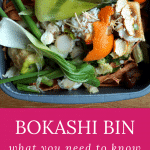
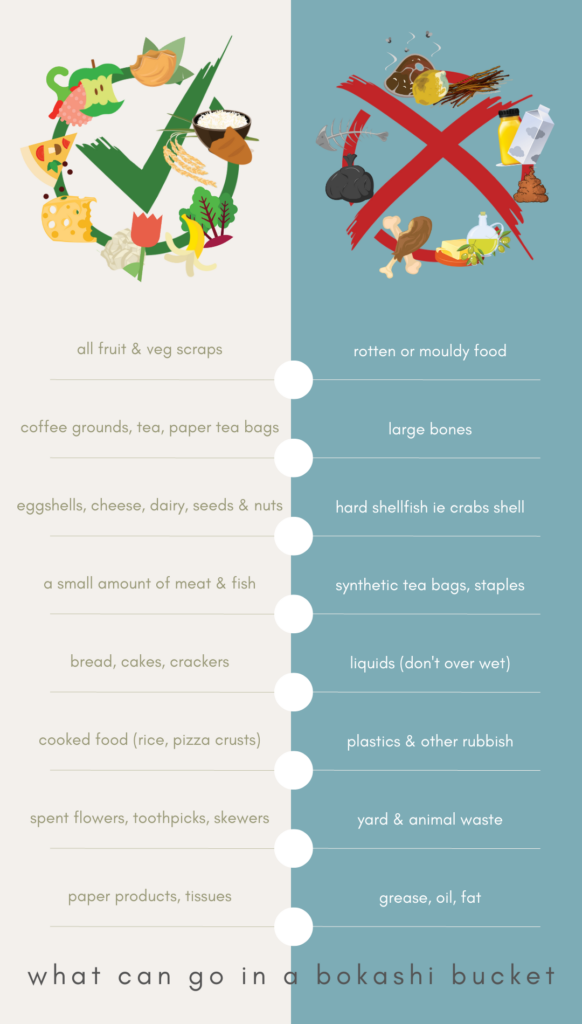
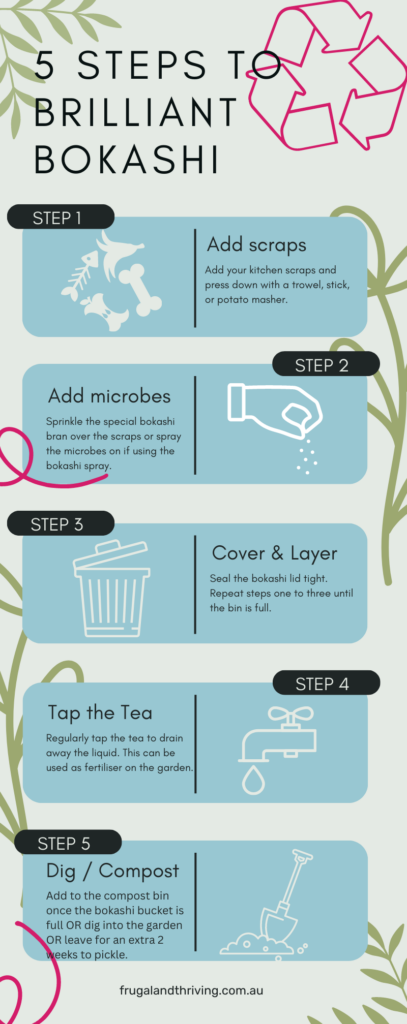
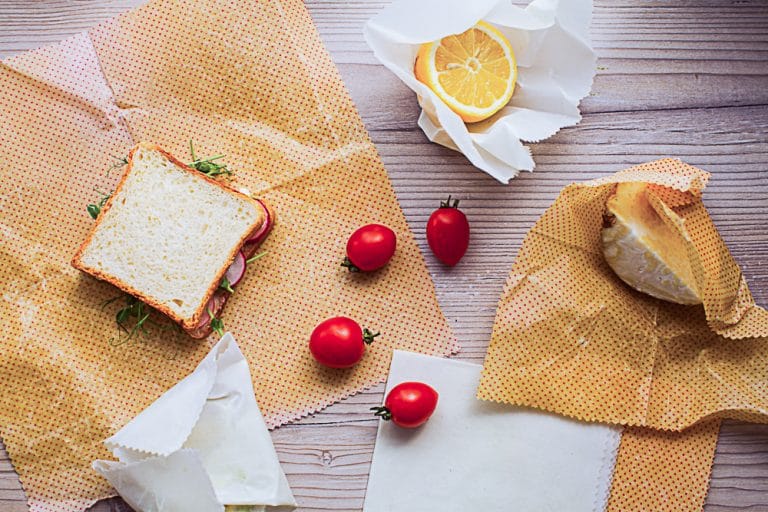
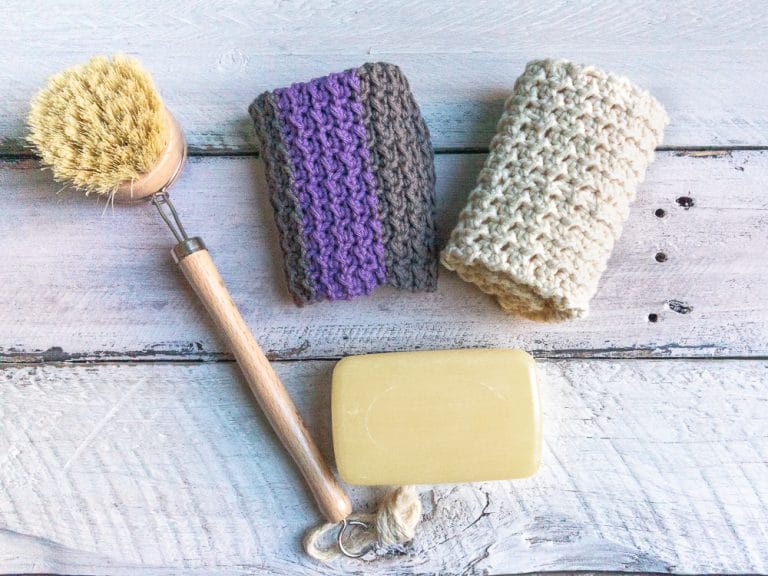
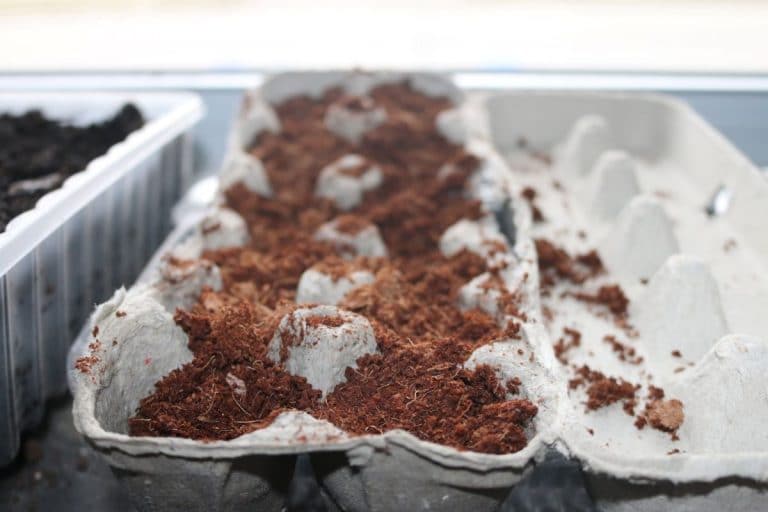
Tech issues meant that some of the latest comments got lost in the ether. Here’s a copy of them. Thank you to the commenters! Melissa xx
“We’ve been using bokashi bins for about 3 years now and I will rave about it to anyone who will listen! We don’t even have a landfill bin in our house so that there isn’t the option to just throw things away mindlessly. I ended up getting two bins so that we could start filling the 2nd and just let the first sit for a while. I posted on a facebook gardening site to find someone interested in have the waste and did the same thing again when we moved to a new city – it definitely wasn’t hard to find eager takers. I would also add that it’s important to regularly drain the tap to avoid smells!”
—
“I Bokashi but don’t have a compost, so I got on this website called sharewaste.com and got in touch with a neighbour who composts! I highly recommend it. ❤️”
—
And this one was emailed – great idea!:
” I use an old blender and water to reduce vegetable/fruit matter, egg shells etc. and pour this liquid directly to flower beds where it does not smell and is quickly assimilated by worms in the garden. Have found this works very well for us. I agree regular composting takes forever and attracts unwanted rodents.”
Hi I have just received my Bokashi bin system, my question is how dies the tap fit into the bottom, does the washer go on the outside or inside if the bin?
Hi, is the bokashi bran the same as EM 4?
I *think* so. It’s best to double-check the bokashi website though.
Melissa,
Thanks so much for this informative and practical article! I appreciate your honest and yet constructive advice about food waste recycling with Bokashi.
I think that there are many factors involved in making behavior changes and your writing definitely supports a step in the right direction, a sustainable direction!
Thanks!
I have been using the Bokashi system for decades. Recently I needed to increase my system from three to four Bokashi bins. Neighbours contribute their kitchen waste and I share the end contents with them for their gardens.
My local supplier of the Bokashi grain has closed. I was excited to see a grain recipe on this post and I wish to make my own. However, can you tell me where I can obtain the microbes in Australia please?
Hi, not sure sorry.